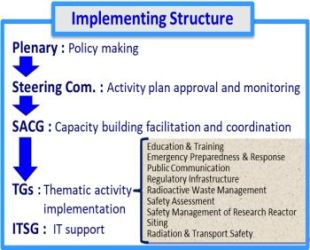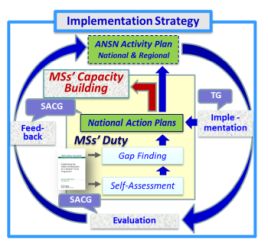What is the Asian Nuclear Safety Network (ANSN)?
Knowledge Network under Global Nuclear Safety and Security Regime
 Nuclear safety and security is a global issue. As for the global nuclear safety and security frameowrk, there are many instruments for achieving high
level of nuclear safety and security on a global bases, such as conventions and codes of conduct,
IAEA safety standards and security guidelines, safety review services and security missions provided by the IAEA.
Nuclear safety and security is a global issue. As for the global nuclear safety and security frameowrk, there are many instruments for achieving high
level of nuclear safety and security on a global bases, such as conventions and codes of conduct,
IAEA safety standards and security guidelines, safety review services and security missions provided by the IAEA.
As far as nuclear safety is concerned, in addition to such international instruments, knowledge networking plays an important
role in establishing and enhancing national and regional nuclear safety infrastructures
that consist of the elements such as safety regulation, operational safety, research
activities and education & training of staffs involved in nuclear safety. Self-sustaining
knowledge networking is expected to be a useful tool for sharing knowledge, experience and expertise, for capacity building in the member states and eventually for achieving high level of nuclear safety of the nuclear installations.
Objectives of the ANSN
 The Asian Nuclear Safety Network (ANSN) was launched in 2002 and fully implemented in 2004 to pool, analyse and
share nuclear safety information, knowledge and experience for peaceful use
among the member states. It is carried out within the framework of the Extra-Budgetary Programme on the Safety of Nuclear Installations in South East Asia, Pacific and Far East Countries. The ANSN was first evolved as a basic information sharing mechanism and then became a human and cyber network for facilitating sustainable regional cooperation to obtain basic and applied nuclear safety knowledge.
The Asian Nuclear Safety Network (ANSN) was launched in 2002 and fully implemented in 2004 to pool, analyse and
share nuclear safety information, knowledge and experience for peaceful use
among the member states. It is carried out within the framework of the Extra-Budgetary Programme on the Safety of Nuclear Installations in South East Asia, Pacific and Far East Countries. The ANSN was first evolved as a basic information sharing mechanism and then became a human and cyber network for facilitating sustainable regional cooperation to obtain basic and applied nuclear safety knowledge.
After several years had passed, in parallel with a global tidal wave of "Nuclear Renaissance" the interest in nuclear power gained momentum in the emerging countries, that led to a discussion that the ANSN activities should shift to focus on nuclear safety capacity building including elements of nuclear power programme.
The “Vision for the ANSN by the Year 2020 (ANSN Vision 2020)” was adopted at the second ANSN Nuclear Safety Strategy Dialogue meeting in Seoul in April, 2009 and since then used as a fundamental document to direct the ANSN activities. The ANSN Vision 2020 had aimed to establish a regional capacity building system consisting of (1) education and training, using existing training centers in member states and virtual training centers utilizing e-libraries and etc. (2) technical support and advisory services, realizing virtual TSOs on the web and (3) peer review and support arrangement. The ANSN Vision 2020 focused on the active use of state-of the art information technology.
But the environment surrounding the ANSN remarkably changed after Fukushima Daiichi nuclear power plant accident occurred in 2011. The IAEA adopted Action Plan on Nuclear Safety at the 55th General Conference in 2011 that member states should undertake necessary actions to further strengthen nuclear safety, emergency preparedness and radiation protection. In the Action Plan, member states planning to embark on a nuclear power programme should develop nuclear safety infrastructure and strengthen and maintain capacity building and the IAEA Secretariat to assist as requested. This implies importance on self-initiative effort of member states.
Under these circumstances, the ANSN settles a new “ANSN Vision” which directs the ANSN to a regional cooperation prioritizing on the member states’ self-initiative effort. The countries deciding on or preparing to embark on a nuclear power programme exert on capacity building, and the countries already utilizing nuclear power provide those countries with useful information, in-depth knowledge, practical experience on nuclear and radiation safety and relevant services. The ANSN aims to contribute to enhance nuclear installations’ safety in the region by all the member states with continuous effort for capacity building through ANSN activities.
The ANSN consists of 11 member states, Bangladesh, China, Indonesia, Japan, Kazakhstan, Republic of Korea, Malaysia, the Philippines, Singapore, Thailand and Viet Nam, four supporting countries, Australia, France, Germany and U.S.A., one associate country of Pakistan and two supporting organizations, ASEAN and EC.
Vision of the ANSN
The ANSN aims to be a sustainable regional network for achieving high level of nuclear safety in Asia.
Mission of the ANSN
The ANSN continuously facilitates and supports the member states in capacity building and fosters sharing of knowledge, experience and expertise in the area of nuclear safety through human and IT networks.
Structure of the ANSN
 The implementing structure of the ANSN is such that, from the top, Plenary for policy making, Steering Committee (SC), as the standing committee, for approval and monitoring of the activity plan, Self-Assessment Coordination Group (SACG) to facilitate member states’ capacity building and coordinate its cross-cutting issues, nine Topical Groups (TGs) and an IT Support Group (ITSG). Each TG implements dedicated thematic activities relating to nuclear safety capacity and the ITSG supports member states in dealing with issues regarding information technology.
The implementing structure of the ANSN is such that, from the top, Plenary for policy making, Steering Committee (SC), as the standing committee, for approval and monitoring of the activity plan, Self-Assessment Coordination Group (SACG) to facilitate member states’ capacity building and coordinate its cross-cutting issues, nine Topical Groups (TGs) and an IT Support Group (ITSG). Each TG implements dedicated thematic activities relating to nuclear safety capacity and the ITSG supports member states in dealing with issues regarding information technology.
Strategy of the ANSN
 The ANSN encourages member states to conduct self-assessment (SA) and develop national action plans (NAPs), establishes the ANSN activity plan based on national action plans, implements the ANSN activity plan to support member states in conducting national action plans and evaluates effectiveness of the ANSN activity plan and member states evaluate capacity building achievement through implementing of national action plans.
The ANSN encourages member states to conduct self-assessment (SA) and develop national action plans (NAPs), establishes the ANSN activity plan based on national action plans, implements the ANSN activity plan to support member states in conducting national action plans and evaluates effectiveness of the ANSN activity plan and member states evaluate capacity building achievement through implementing of national action plans.